Moisture Transfer Finite Element Modeling with Soil-Water Characteristic Curve-Based Parameters and its Application to Nhan Co Red Mud Basin Slope
Since the year of 2017, landslides at the red mud basins in Nhan Co alumina factory, Dak
Nong province have been occurring during the rainy season. The change of the soil physical and
mechanical parameters due to rainwater infiltration has been considered as the main factor of the
slope instability. The soil cohesion and angle of internal friction depend greatly on the soil moisture.
Specifically, soil with a lower moisture content has a higher shearing strength than that in soil with
higher moisture content. The finite element modeling of moisture transfers in unsaturated soils
through the relationship between soil moisture, soil suction, unsaturated permeability and soilmoisture dispersivity is capable of accurately predicting the wetting front development. The element
sizes and time steps have been selected based on detailed analysis of analytical error estimation and
on the numerical simulations with different element sizes numerical simulation errors. Soil samples
had been taken then the soil different suctions and corresponding soil moisture values have been
determined in the laboratory. The soil water characteristic curve (SWCC) parameters (a, n and m)
have been determined by the best fitting using the least squared error method. The hydraulic
conductivity of the saturated soil, one of the key input parameters was also determined. The results
of the application to the study area's slope has shown that the wetting front depth could be up to 8
meters for 90 days of moisture transfer due to the rainwater infiltration. The wetting front depth and
the length of the intermediate part of the moisture distribution curve have increased with the
infiltration time.
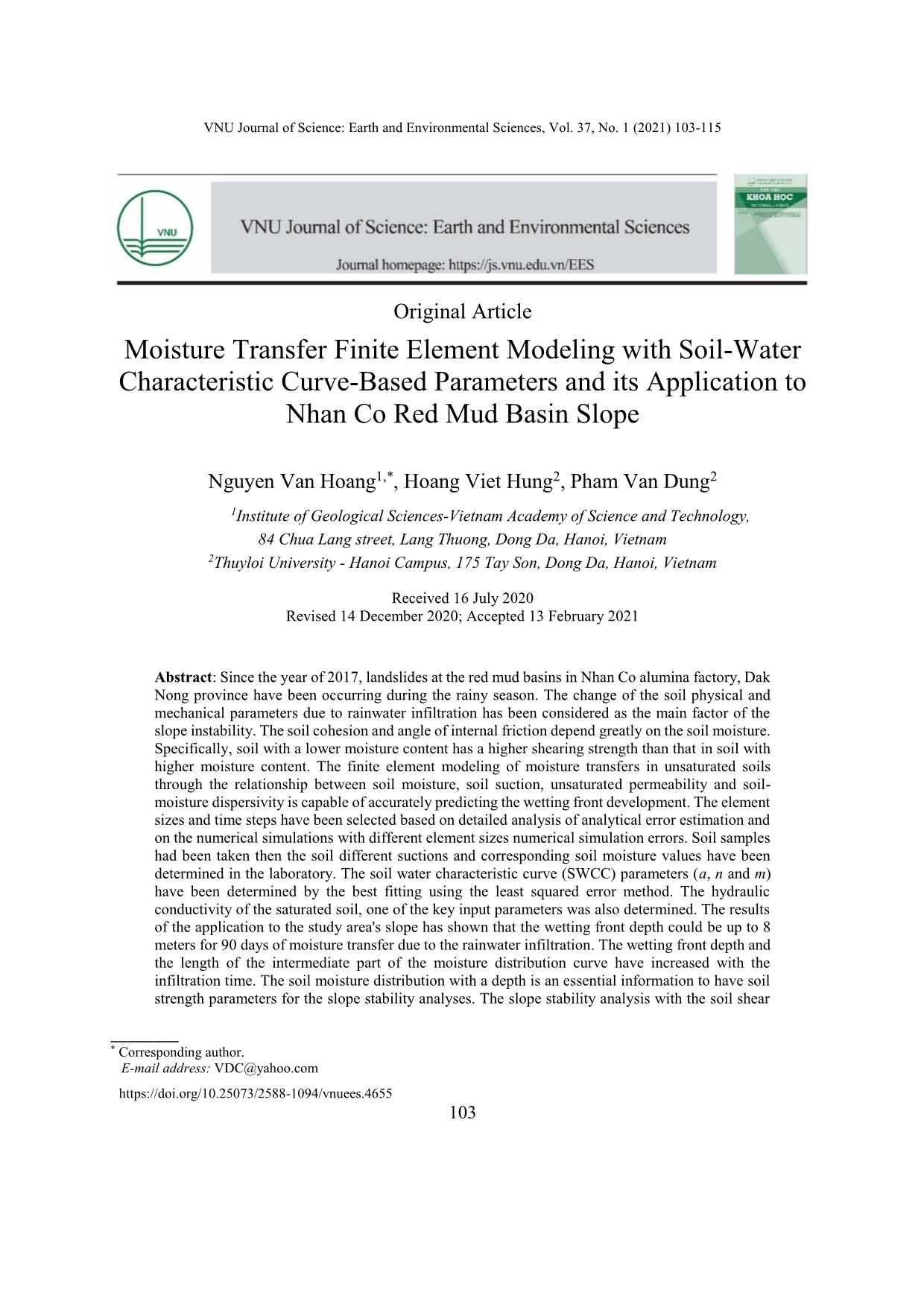
Trang 1
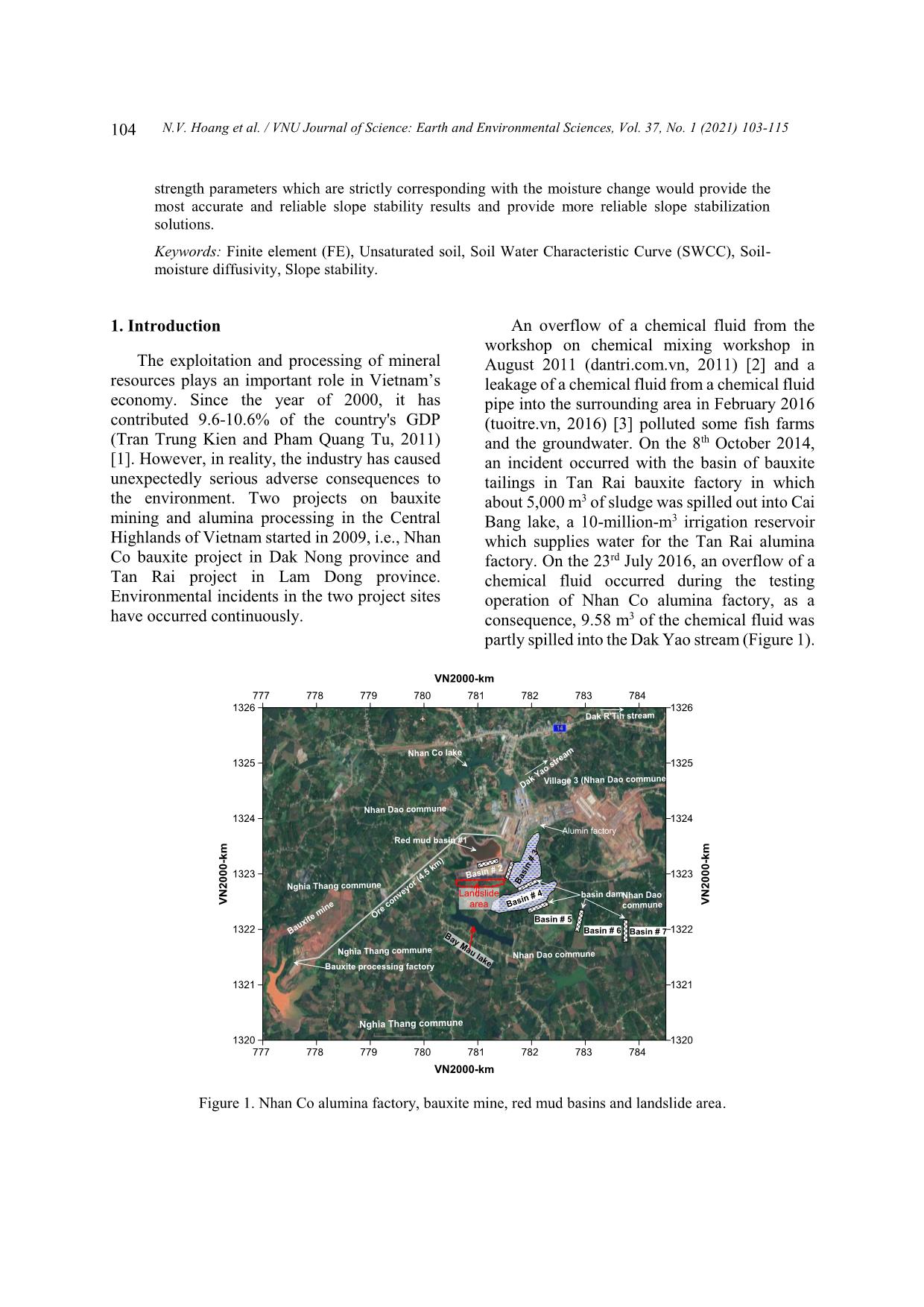
Trang 2
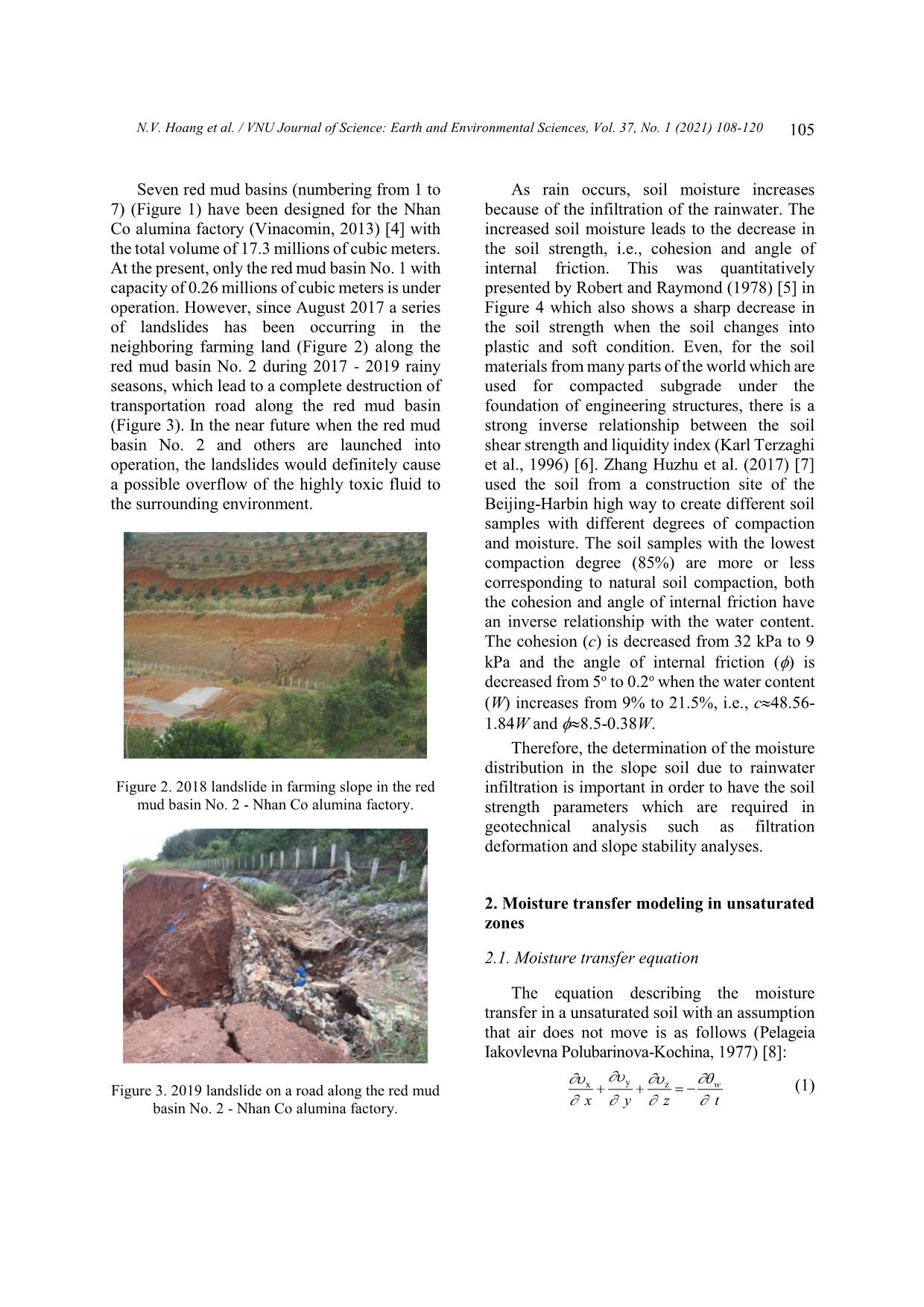
Trang 3
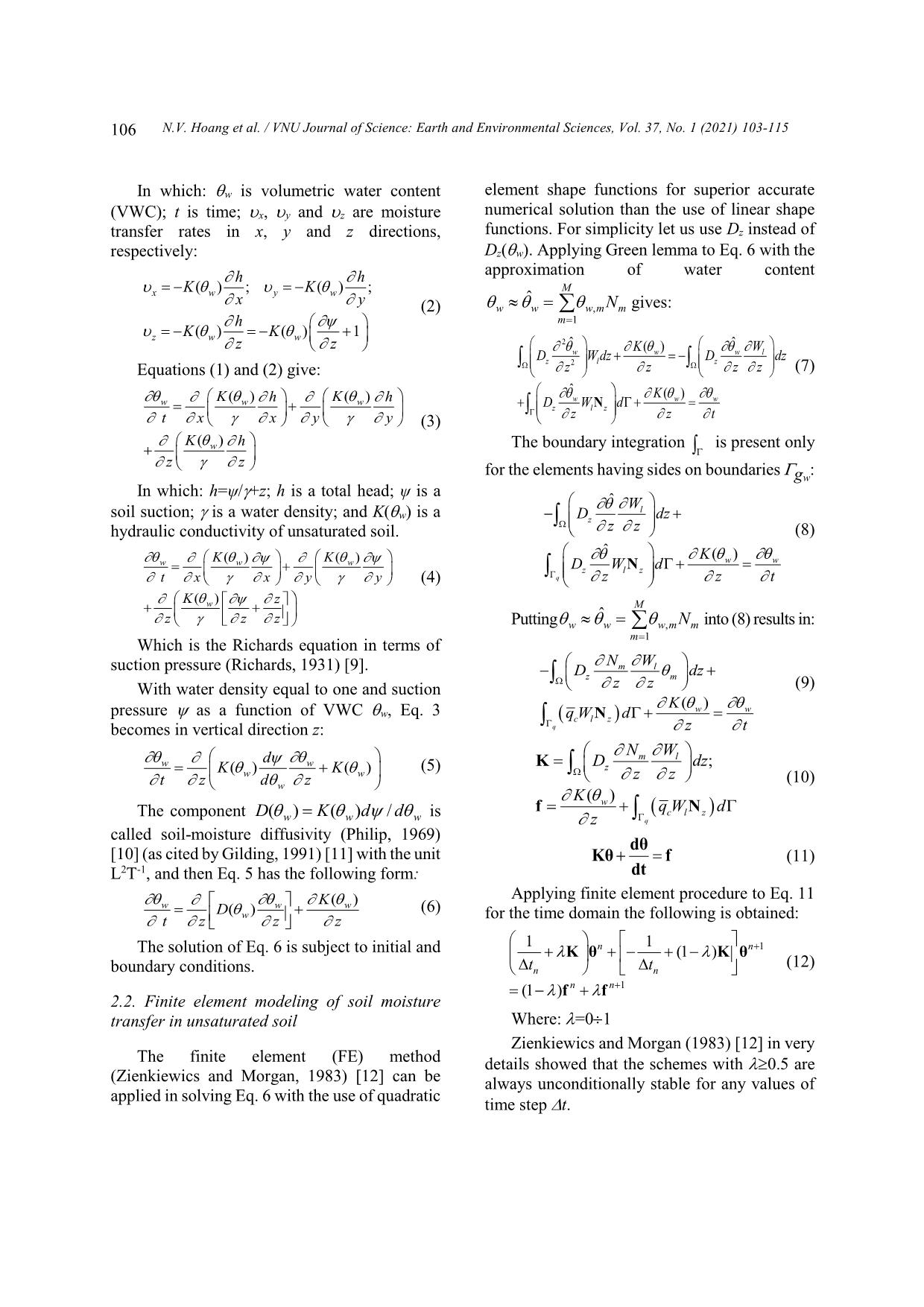
Trang 4
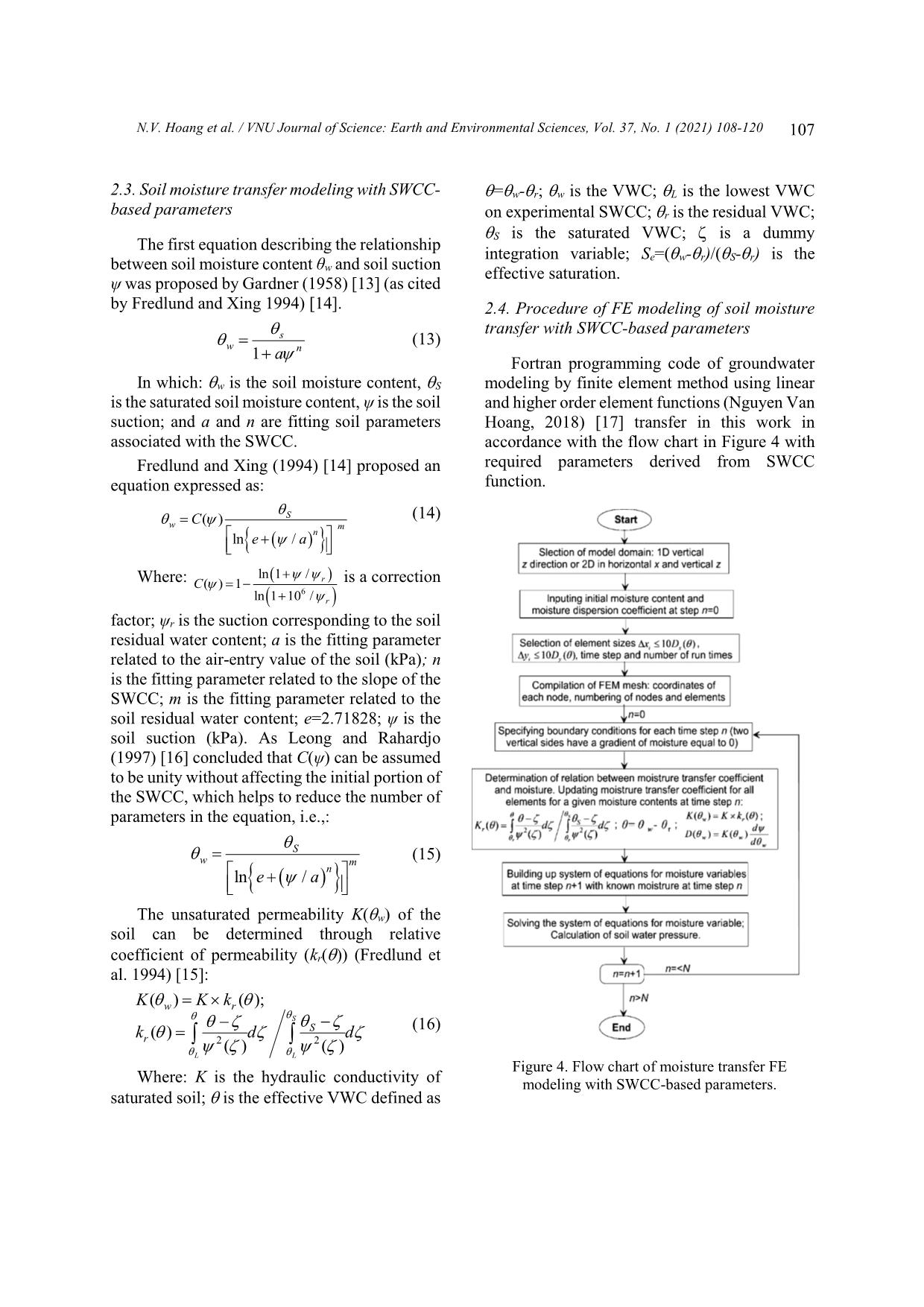
Trang 5
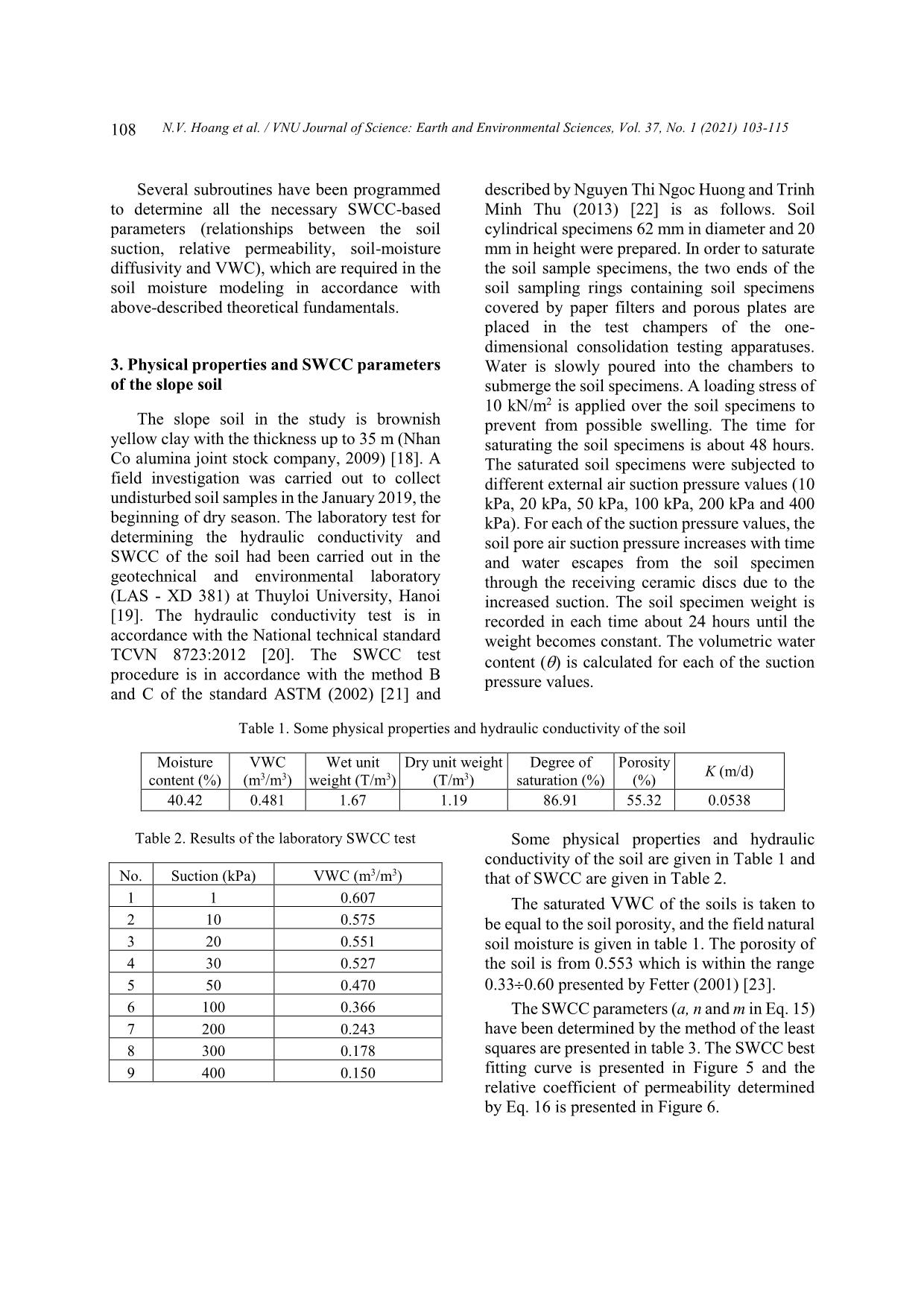
Trang 6
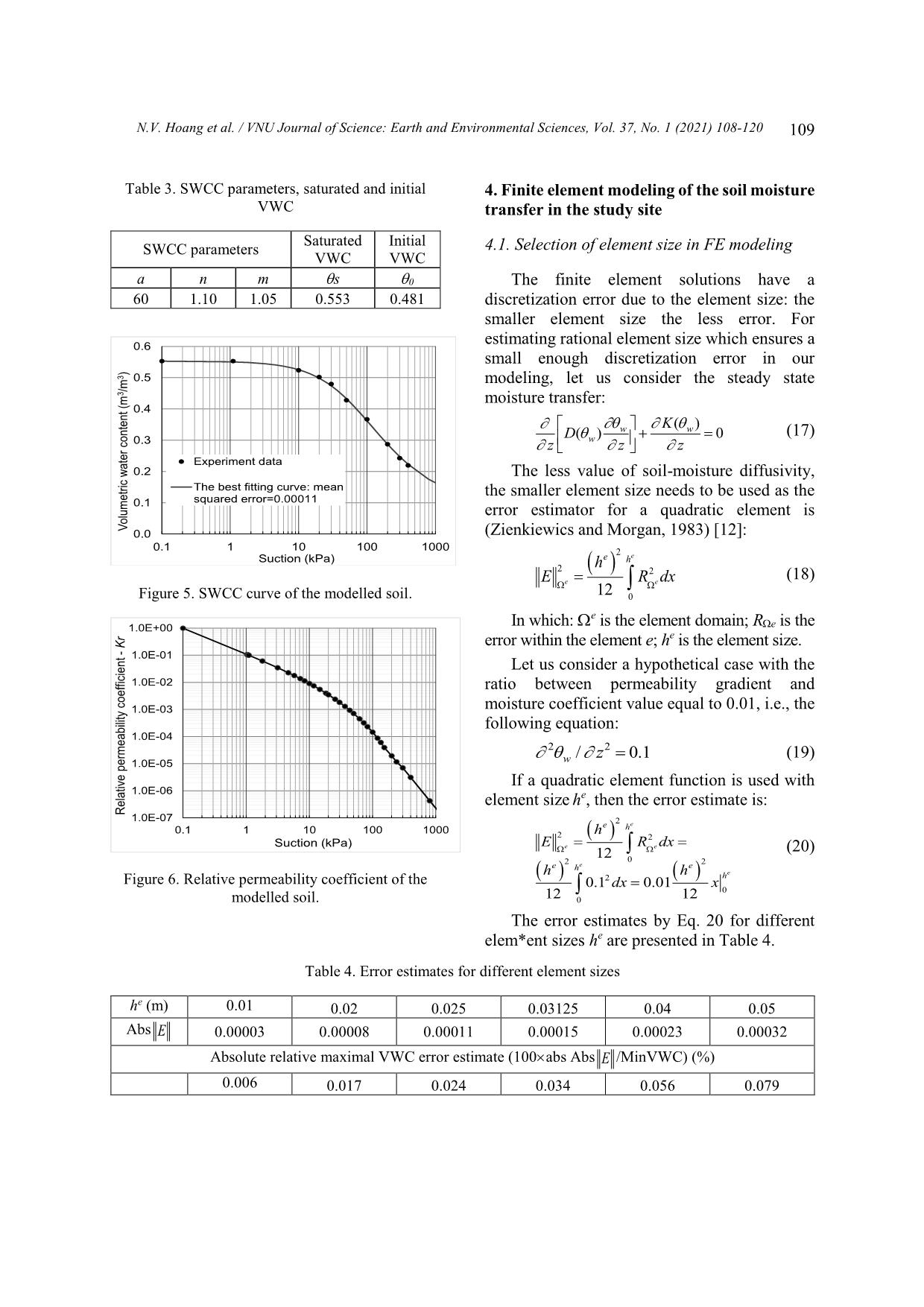
Trang 7
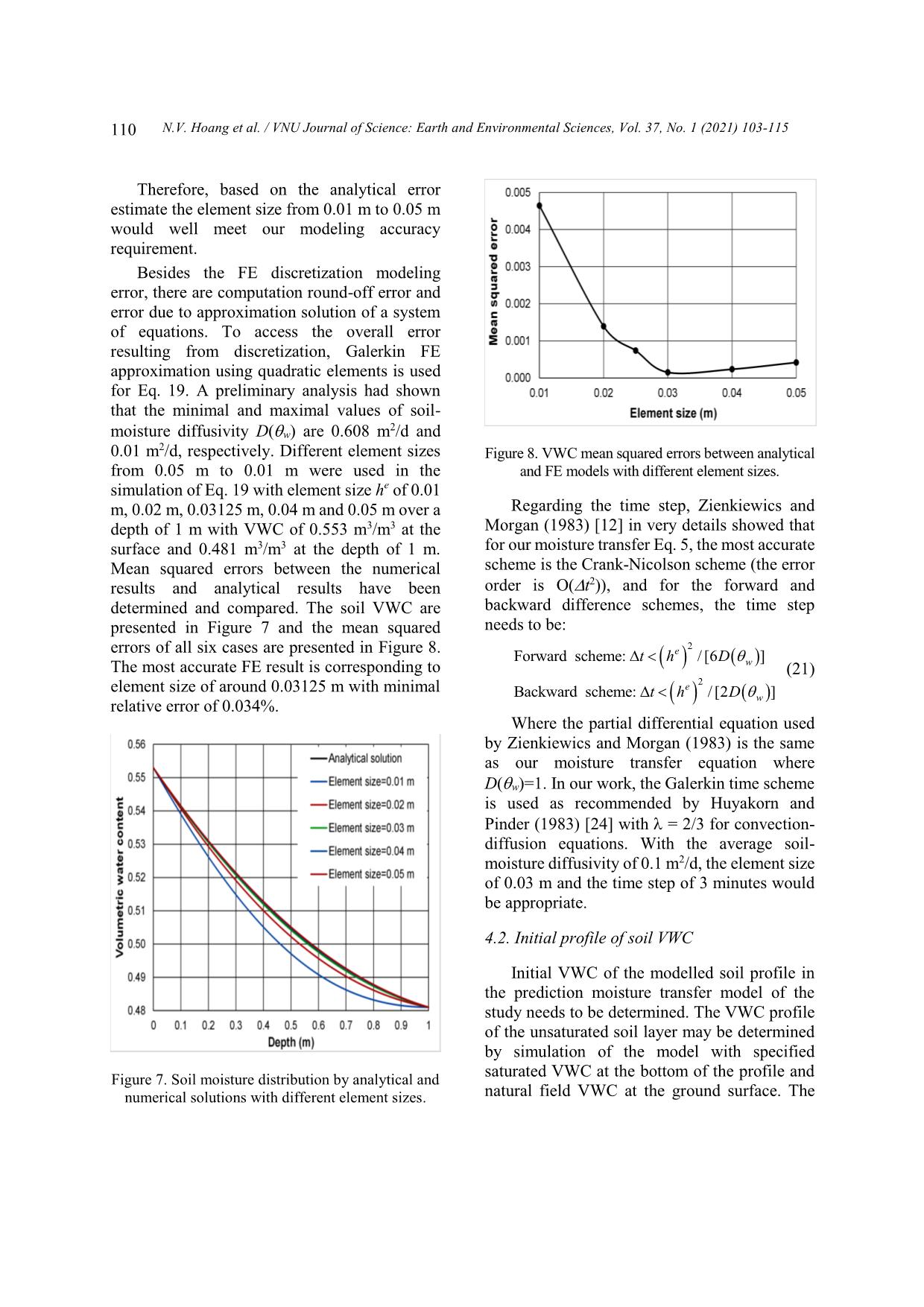
Trang 8
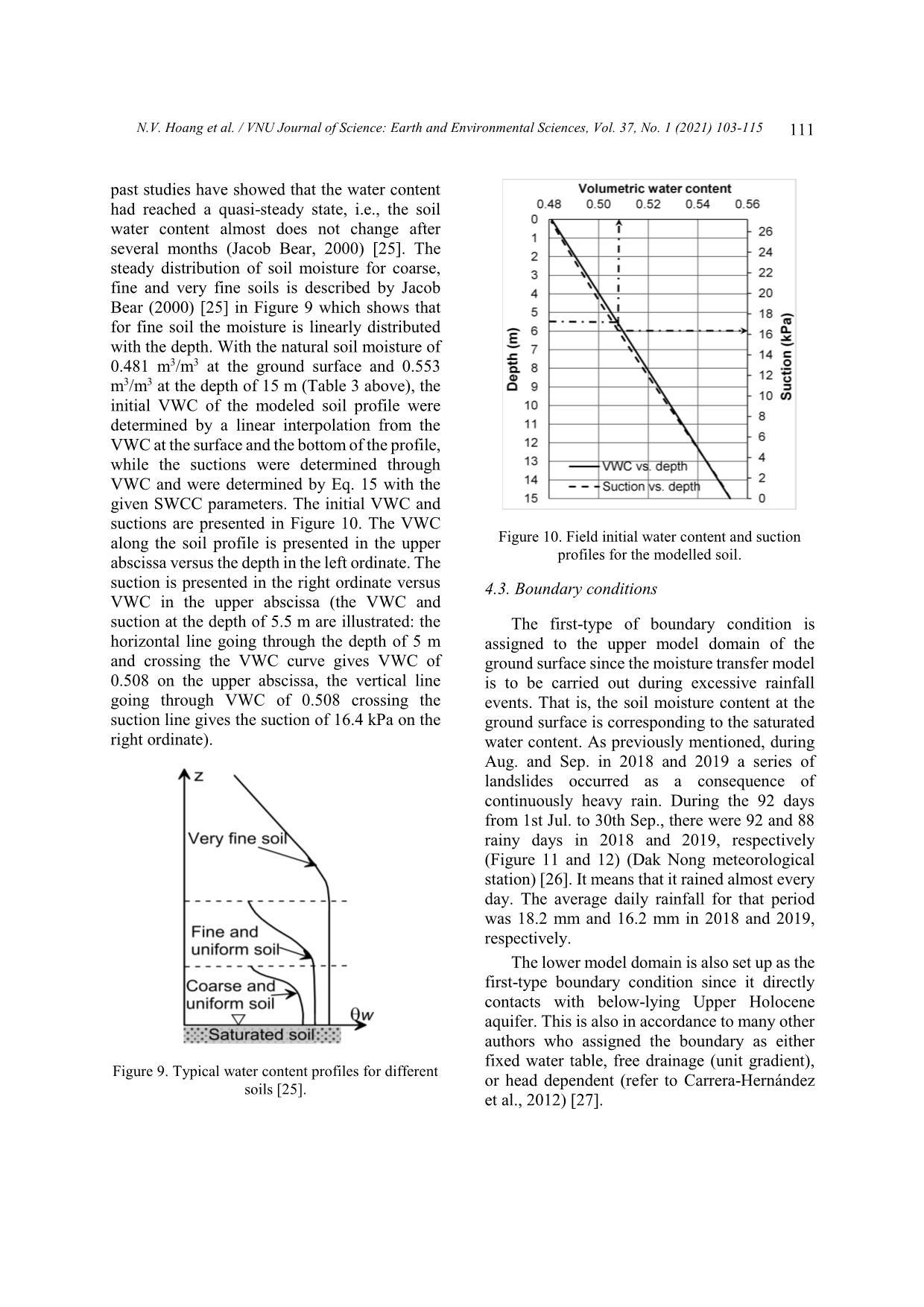
Trang 9
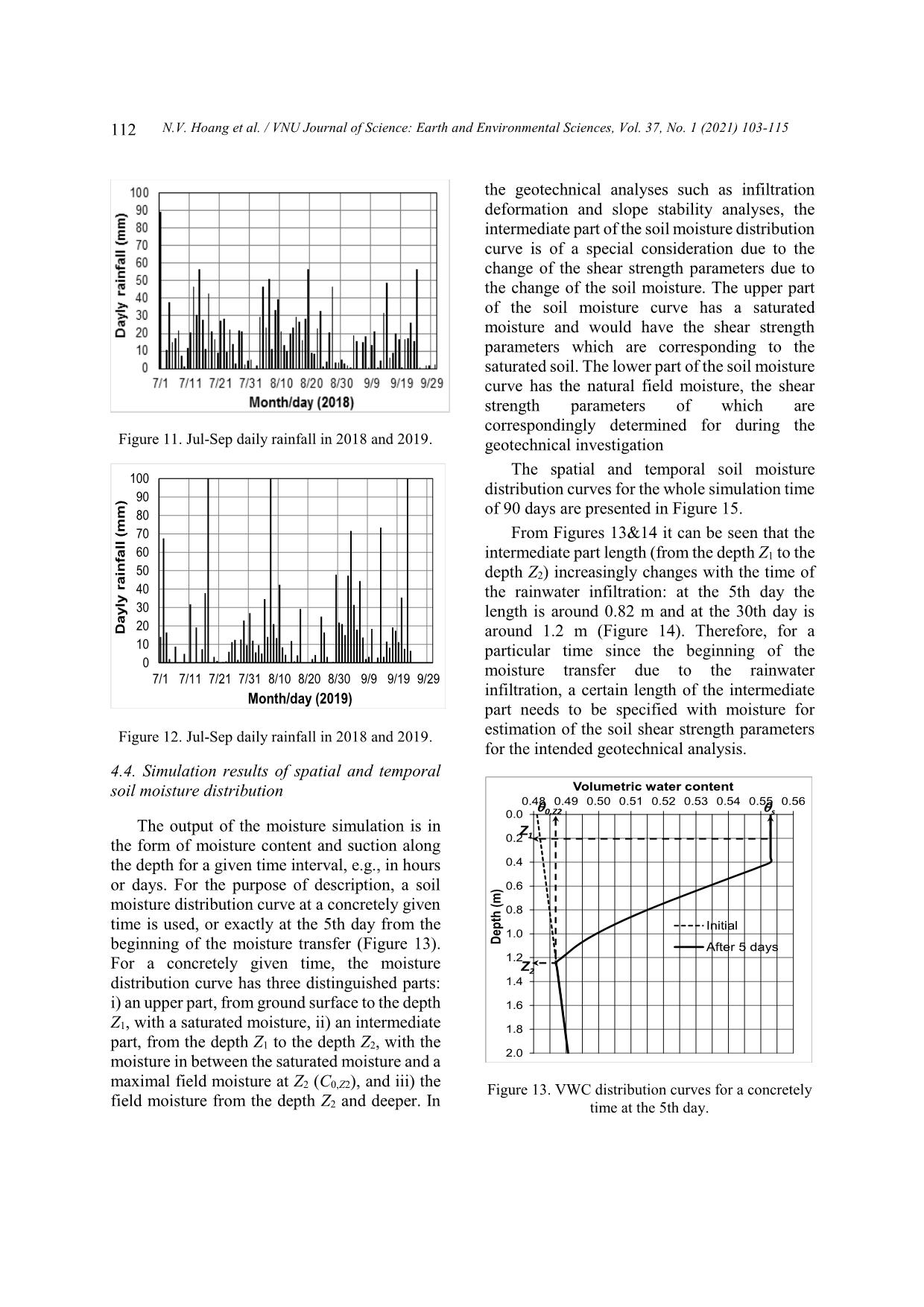
Trang 10
Tải về để xem bản đầy đủ
Tóm tắt nội dung tài liệu: Moisture Transfer Finite Element Modeling with Soil-Water Characteristic Curve-Based Parameters and its Application to Nhan Co Red Mud Basin Slope
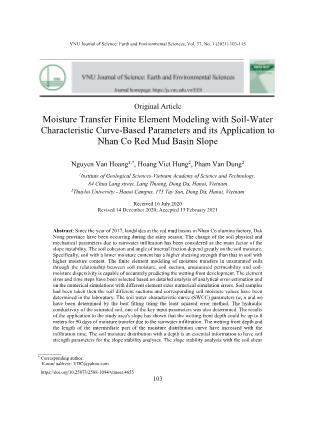
VNU Journal of Science: Earth and Environmental Sciences, Vol. 37, No. 1 (2021) 103-115 103 Original Article Moisture Transfer Finite Element Modeling with Soil-Water Characteristic Curve-Based Parameters and its Application to Nhan Co Red Mud Basin Slope Nguyen Van Hoang1,*, Hoang Viet Hung2, Pham Van Dung2 1Institute of Geological Sciences-Vietnam Academy of Science and Technology, 84 Chua Lang street, Lang Thuong, Dong Da, Hanoi, Vietnam 2Thuyloi University - Hanoi Campus, 175 Tay Son, Dong Da, Hanoi, Vietnam Received 16 July 2020 Revised 14 December 2020; Accepted 13 February 2021 Abstract: Since the year of 2017, landslides at the red mud basins in Nhan Co alumina factory, Dak Nong province have been occurring during the rainy season. The change of the soil physical and mechanical parameters due to rainwater infiltration has been considered as the main factor of the slope instability. The soil cohesion and angle of internal friction depend greatly on the soil moisture. Specifically, soil with a lower moisture content has a higher shearing strength than that in soil with higher moisture content. The finite element modeling of moisture transfers in unsaturated soils through the relationship between soil moisture, soil suction, unsaturated permeability and soil- moisture dispersivity is capable of accurately predicting the wetting front development. The element sizes and time steps have been selected based on detailed analysis of analytical error estimation and on the numerical simulations with different element sizes numerical simulation errors. Soil samples had been taken then the soil different suctions and corresponding soil moisture values have been determined in the laboratory. The soil water characteristic curve (SWCC) parameters (a, n and m) have been determined by the best fitting using the least squared error method. The hydraulic conductivity of the saturated soil, one of the key input parameters was also determined. The results of the application to the study area's slope has shown that the wetting front depth could be up to 8 meters for 90 days of moisture transfer due to the rainwater infiltration. The wetting front depth and the length of the intermediate part of the moisture distribution curve have increased with the infiltration time. The soil moisture distribution with a depth is an essential information to have soil strength parameters for the slope stability analyses. The slope stability analysis with the soil shear ________ * Corresponding author. E-mail address: VDC@yahoo.com https://doi.org/10.25073/2588-1094/vnuees.4655 N.V. Hoang et al. / VNU Journal of Science: Earth and Environmental Sciences, Vol. 37, No. 1 (2021) 103-115 104 strength parameters which are strictly corresponding with the moisture change would provide the most accurate and reliable slope stability results and provide more reliable slope stabilization solutions. Keywords: Finite element (FE), Unsaturated soil, Soil Water Characteristic Curve (SWCC), Soil- moisture diffusivity, Slope stability. 1. Introduction The exploitation and processing of mineral resources plays an important role in Vietnam’s economy. Since the year of 2000, it has contributed 9.6-10.6% of the country's GDP (Tran Trung Kien and Pham Quang Tu, 2011) [1]. However, in reality, the industry has caused unexpectedly serious adverse consequences to the environment. Two projects on bauxite mining and alumina processing in the Central Highlands of Vietnam started in 2009, i.e., Nhan Co bauxite project in Dak Nong province and Tan Rai project in Lam Dong province. Environmental incidents in the two project sites have occurred continuously. An overflow of a chemical fluid from the workshop on chemical mixing workshop in August 2011 (dantri.com.vn, 2011) [2] and a leakage of a chemical fluid from a chemical fluid pipe into the surrounding area in February 2016 (tuoitre.vn, 2016) [3] polluted some fish farms and the groundwater. On the 8th October 2014, an incident occurred with the basin of bauxite tailings in Tan Rai bauxite factory in which about 5,000 m3 of sludge was spilled out into Cai Bang lake, a 10-million-m3 irrigation reservoir which supplies water for the Tan Rai alumina factory. On the 23rd July 2016, an overflow of a chemical fluid occurred during the testing operation of Nhan Co alumina factory, as a consequence, 9.58 m3 of the chemical fluid was partly spilled into the Dak Yao stream (Figure 1). Figure 1. Nhan Co alumina factory, bauxite mine, red mud basins and landslide area. N.V. Hoang et al. / VNU Journal of Science: Earth and Environmental Sciences, Vol. 37, No. 1 (2021) 108-120 105 Seven red mud basins (numbering from 1 to 7) (Figure 1) have been designed for the Nhan Co alumina factory (Vinacomin, 2013) [4] with the total volume of 17.3 millions of cubic meters. At the present, only the red mud basin No. 1 with capacity of 0.26 millions of cubic meters is under operation. However, since August 2017 a series of landslides has been occurring in the neighboring farming land (Figure 2) along the red mud basin No. 2 during 2017 - 2019 rainy seasons, which lead to a complete destruction of transportation road along the red mud basin (Figure 3). In the near future when the red mud basin No. 2 and others are launched into operation, the landslides would definitely cause a possible overflow of the highly toxic fluid to the surrounding environment. Figure 2. 2018 landslide in farming slope in the red mud basin No. 2 - Nhan Co alumina factory. Figure 3. 2019 landslide on a road along the red mud basin No. 2 - Nhan Co alumina factory. As rain occurs, soil moisture increases because of the infiltration of the rainwater. The increased soil moisture leads to the decrease in the soil strength, i.e., cohesion and angle of internal ... and the bottom of the profile, while the suctions were determined through VWC and were determined by Eq. 15 with the given SWCC parameters. The initial VWC and suctions are presented in Figure 10. The VWC along the soil profile is presented in the upper abscissa versus the depth in the left ordinate. The suction is presented in the right ordinate versus VWC in the upper abscissa (the VWC and suction at the depth of 5.5 m are illustrated: the horizontal line going through the depth of 5 m and crossing the VWC curve gives VWC of 0.508 on the upper abscissa, the vertical line going through VWC of 0.508 crossing the suction line gives the suction of 16.4 kPa on the right ordinate). Figure 9. Typical water content profiles for different soils [25]. Figure 10. Field initial water content and suction profiles for the modelled soil. 4.3. Boundary conditions The first-type of boundary condition is assigned to the upper model domain of the ground surface since the moisture transfer model is to be carried out during excessive rainfall events. That is, the soil moisture content at the ground surface is corresponding to the saturated water content. As previously mentioned, during Aug. and Sep. in 2018 and 2019 a series of landslides occurred as a consequence of continuously heavy rain. During the 92 days from 1st Jul. to 30th Sep., there were 92 and 88 rainy days in 2018 and 2019, respectively (Figure 11 and 12) (Dak Nong meteorological station) [26]. It means that it rained almost every day. The average daily rainfall for that period was 18.2 mm and 16.2 mm in 2018 and 2019, respectively. The lower model domain is also set up as the first-type boundary condition since it directly contacts with below-lying Upper Holocene aquifer. This is also in accordance to many other authors who assigned the boundary as either fixed water table, free drainage (unit gradient), or head dependent (refer to Carrera-Hernández et al., 2012) [27]. N.V. Hoang et al. / VNU Journal of Science: Earth and Environmental Sciences, Vol. 37, No. 1 (2021) 103-115 112 Figure 11. Jul-Sep daily rainfall in 2018 and 2019. Figure 12. Jul-Sep daily rainfall in 2018 and 2019. 4.4. Simulation results of spatial and temporal soil moisture distribution The output of the moisture simulation is in the form of moisture content and suction along the depth for a given time interval, e.g., in hours or days. For the purpose of description, a soil moisture distribution curve at a concretely given time is used, or exactly at the 5th day from the beginning of the moisture transfer (Figure 13). For a concretely given time, the moisture distribution curve has three distinguished parts: i) an upper part, from ground surface to the depth Z1, with a saturated moisture, ii) an intermediate part, from the depth Z1 to the depth Z2, with the moisture in between the saturated moisture and a maximal field moisture at Z2 (C0,Z2), and iii) the field moisture from the depth Z2 and deeper. In the geotechnical analyses such as infiltration deformation and slope stability analyses, the intermediate part of the soil moisture distribution curve is of a special consideration due to the change of the shear strength parameters due to the change of the soil moisture. The upper part of the soil moisture curve has a saturated moisture and would have the shear strength parameters which are corresponding to the saturated soil. The lower part of the soil moisture curve has the natural field moisture, the shear strength parameters of which are correspondingly determined for during the geotechnical investigation The spatial and temporal soil moisture distribution curves for the whole simulation time of 90 days are presented in Figure 15. From Figures 13&14 it can be seen that the intermediate part length (from the depth Z1 to the depth Z2) increasingly changes with the time of the rainwater infiltration: at the 5th day the length is around 0.82 m and at the 30th day is around 1.2 m (Figure 14). Therefore, for a particular time since the beginning of the moisture transfer due to the rainwater infiltration, a certain length of the intermediate part needs to be specified with moisture for estimation of the soil shear strength parameters for the intended geotechnical analysis. Figure 13. VWC distribution curves for a concretely time at the 5th day. 0 10 20 30 40 50 60 70 80 90 100 7/1 7/11 7/21 7/31 8/10 8/20 8/30 9/9 9/19 9/29 D a y ly r a in fa ll ( m m ) Month/day (2019) 0.0 0.2 0.4 0.6 0.8 1.0 1.2 1.4 1.6 1.8 2.0 0.48 0.49 0.50 0.51 0.52 0.53 0.54 0.55 0.56 D e p th ( m ) Volumetric water content Initial After 5 days 0,Z2 s Z1 Z2 N.V. Hoang et al. / VNU Journal of Science: Earth and Environmental Sciences, Vol. 37, No. 1 (2021) 103-115 113 Figure 14. Temporal VWC distribution curves during 90 days. Figure 15. Wetting front curves in the slope along red mud basin No. 2. Figure 16. Typical slip circles in regard to soil moisture and groundwater. Figure 16 presents three typical circles in the slope safety analysis: circle 1 is entirely within the saturated which has lowest shear strength parameters; circle 2 has a long part in the soil mass with a natural field moisture, and circle has a long part in the saturated soil mass with a buoyancy force effect. Among the three circles, circles 1 and 3 would have lowest factor of safety. 5. Concluding remarks The finite element modeling of simulation of moisture transfer in unsaturated soils is a complicated and powerful tool which is capable of accurately determining the soil moisture distribution in time and space. The SWCC parameters are also time-consuming and expensively determined in the laboratory. Those two aspects in combination are challenging the unsaturated soil mechanics and hydraulics. Those laboratory test experiments and numerical modeling have been carried out for the slope of the red mud basin No. 2 in Nhan Co alumina factory in Dak Nong province. The SWCC parameters of the study soil are a=60, n=1.10 and m=1.05, which have been determined by the best fitting using the least squared error method, the mean squared error of which is very low and equal to 0.00011. The optimal finite element size for the soil under consideration is around 0.03 m, which had been selected based both on the analytical error estimation and on the numerical simulations with different element sizes. The results of the application to the study area's slope has shown that the wetting front depth can be up to 8 meters for 90 days of moisture transfer in the due to the rainfall. The wetting front depth and the length of the intermediate part of the moisture distribution curve have increased with the infiltration time. The soil moisture distribution with a depth is an essential information to have soil strength parameters for the slope stability analyses. Once, the moisture distribution at a particular time since the beginning of the 0 1 2 3 4 5 6 7 8 9 10 11 12 13 14 15 0.48 0.49 0.50 0.51 0.52 0.53 0.54 0.55 0.56 D e p th ( m ) Volumetric water content N.V. Hoang et al. / VNU Journal of Science: Earth and Environmental Sciences, Vol. 37, No. 1 (2021) 103-115 114 moisture transfer due to the rain, the intermediate part of depth needs to be specified with moisture content for the estimation of the soil shear strength parameters for the intended geotechnical slope analysis. The slope stability analysis with the soil shear strength parameters which are strictly corresponding with the moisture change would provide the most accurate and reliable slope stability results and provide more reliable slope stabilization solutions. There is a limitation matter remains the the study and would be interesting to be studied in derails. The upper boundary condition was set to be the first kind, i.e., a specified constant VWC during the entire modelled time domain based on the reality of 92 days of continuous rainfall, the mean rainfall intensity of which is 16.2 mm 18.2 mm. The evaporation and excess moisture in the form of condensation for the air temperature drops below its dew point at the ground surface need to be identified for more precise specification of the boundary condition and boundary value of the ground surface. In this case, the upper boundary condition would be specified variable VWC or specified variable moisture flux etc. The effect of the boundary condition and boundary value on the moisture transfer results would assist in selecting a more appropriate boundary condition of the reality, Acknowledgement This paper was completed with the support of the project Code KC.08.23/16-20 financed by Ministry of Science and Technology of Vietnam. The authors would like to express a sincere gratitude for the support. References [1] T.T. Kien and P.Q. Tu. The role of NGOs in policy criticism: The case of the Consultancy on Development Institute in the sustainable management of mineral resources in Vietnam. Report of the Consultancy on Development Institute (CODE). Ha Noi, Vietnam (2011) (in Vietnamese). [2] https://dantri.com.vn/kinh-doanh/boxit-tan-rai- tran-hoa-chat-ra-moi-truong-su-co-nho-thiet-hai- lon-1317152926.htm (archived on 24 Sep. 2011) (in Vietnamese). [3] https://tuoitre.vn/nha-may-boxit-tan-rai-ong-chua- xut-vo-do-lao-hoa-khop-noi-1052089.htm (archived on 16 Feb. 2016) (in Vietnamese). [4] Vinacomin. Environmental impact assessment for Nhan Co - Dak Nong bauxite mining. Dak Nong, Vietnam (2013) (in Vietnamese). [5] L. Rober, Schuster and R.J. Krizek. Landslides, analysis and control. National Academy of Sciences, Washington (1978); pp. 234. [6] K. Terzaghi, R. B. Peck and G. Mesri. Soil mechanics in engineering practice. John Wiley & Sons Inc. (1996). pp. 512. [7] Z. Huzhu, L.Hanbing, W.Jing and D. Weizhi. Investigation of the effect of water content and degree of compaction on the shear strength of clay soil material. Functional Materials. 24(2) (2017), 290-297. ISSN 1027-5495. [8] Pelageia Iakovlevna Polubarinova-Kochina. Theory of ground water movement. Publishers "Science" (in Russian) (1977) pp. 664. [9] L.A. Richards Capillary conduction of liquids through porous mediums, Physics, 1 (1931) 318-333. [10] J.R. Philip Theory of infiltration. In Advances in Hydroscience Ven Te Chow (editor). Volume 5, Academic Press, New York (1969) 215-296. [11] B.H. Gilding Qualitative Mathematical Analysis of the Richards Equation. Transport in Porous Media 5(1991) 651-666. [12] O.C. Zienkiewics and K. Morgan Finite Elements and Approximation. John Willey & Sons (1983) pp. 328. [13] W.R. Gardner. Some steady state solutions of the unsaturated moisture flow equation with application to evaporation from a water table. Soil Science, 85(1958) 228-232. doi:10.1097/00010694-195804000-00006. [14] D.G. Fredlund and A. Xing. Equations for the soil- water characteristic curve. Canadian Geotechnical Journal, 31(3) (1994) 521-532. [15] D.G. Fredlund., A. Xing and S. Huang Predicting the permeability function for unsaturated soils using the soil–water characteristic curve. Canadian Geotechnical Journal, 31(3) (1994) 533–546. [16] E.C. Leong and R.H. Permeability functions for unsaturated soils. Journal of geotechnical and geoenvironmental engineering. Dec. 1997. (1997) 1118-1126. N.V. Hoang et al. / VNU Journal of Science: Earth and Environmental Sciences, Vol. 37, No. 1 (2021) 103-115 115 [17] N.V. Hoang. Study on building finite element modeling software to simulate groundwater flow and pollutant and salt transport by groundwater- application to the Vietnam Central coast plain. Vietnam NAFOSTED and Vietnam Ministry of Science and Technology. Project's code: ĐT.NCCB-ĐHƯD.2012-G/04 (2018) (in Vietnamese). [18] Nhan Co alumina joint stock company. Environmental impact assessment for Nhan Co alumina factory in Nhan Co commune, Dak R'lap district, Dak Nong province. Dak Nong, Vietnam (2009) (in Vietnamese). [19] Thuyloi University, Hanoi. [20] TCVN 8723 : 2012. Soil for hydraulic engineering construction - Laboratory test method for determination of permeability coefficient of soil (2012) (in Vietnamese). [21] ASTM D6836-02: Standard Test Method for Determination of the Soil Water Characteristic Curve for Desorption Using Hanging Column, Pressure Extractor, Chilled Mirror Hygrometer, and/or Centrifuge. Annual Book of ASTM Standards, Volume 04.09 (2002). [22] N.T.N. Huong and T.M. Thu. Determining shear strength of an unsaturated soil by the direct shear tests. J. of Water Resources & Environmental Engineering 42(9) (2013) (in Vietnamese). [23] C.W. Fetter. Applied Hydrogeology. Prentice Hall- Upper Saddle River, NJ 07458. (2001) pp. 598. [24] P.S. Huyakorn and G. F Pinder. Computational method in subsurface flow. Academic Press Inc. (1983) pp. 473. [25] J Bear. Computer-Mediated Distance Learning Course on modeling groundwater flow and contaminant transport. Topic D: modeling flow in the unsaturated zone (2000). Faculty of Civil Engineering Technion-Israel Institute of Technology. Haifa 32000, Israel. [26] Dak Nong meteorology station. Monitored daily precipitation of the 2018 and 2019 years. Dak Nong, Vietnam (2020) (in Vietnamese). [27] J.J. Carrera-Hernández, B.D. Smerdon and C.A. Mendoza. Estimating groundwater recharge through unsaturated flow modeling: Sensitivity to boundary conditions and vertical discretization. Journal of Hydrology 452–453 (2012) 90–101.
File đính kèm:
 moisture_transfer_finite_element_modeling_with_soil_water_ch.pdf
moisture_transfer_finite_element_modeling_with_soil_water_ch.pdf

